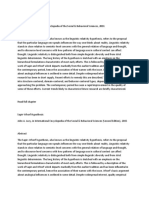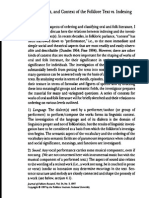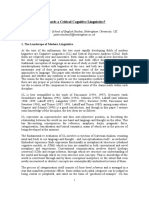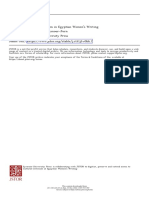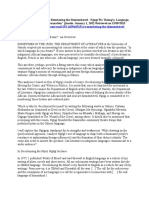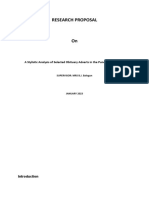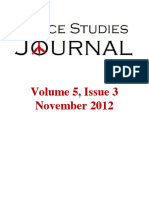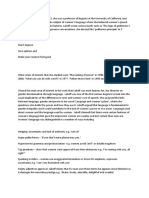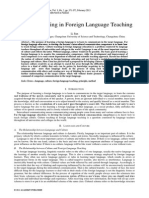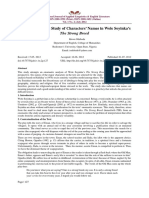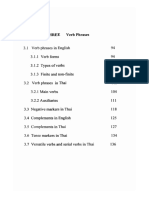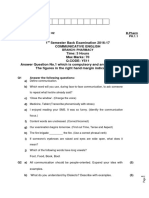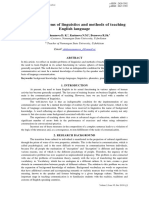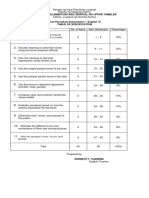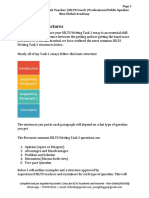Staging Language: An Introduction To The Sociolinguistics of Performance
Uploaded by
Sepsi LászlóStaging Language: An Introduction To The Sociolinguistics of Performance
Uploaded by
Sepsi LászlóJournal of Sociolinguistics 15/5, 2011: 555–572
Staging language: An introduction to the
sociolinguistics of performance
Allan Bell and Andy Gibson
Auckland University of Technology, New Zealand
Staged performance involves the overt, scheduled identification and
elevation of one or more people to perform, with a clearly demarcated
distinction between them and the audience. It involves the agentive use
of language, building on the foundation of existing social meanings. Staged
performances tend to be linguistically stylized, pushing the limits of language
creativity. They have the potential to trigger significant sociolinguistic
effects, circulating novel forms and contributing to language change. The
paradigms used in this theme issue for approaching language performance
include Bakhtin’s notion of Stylization, Bell’s Audience and Referee Design,
Silverstein’s Indexicality, Agha’s Enregisterment, and Bauman’s construct of
Discursive Culture. Themes that run through the articles include: a concept
of identity that is part product, part process; the centrality of the audience;
the reflexivity of staged performance; and the importance of non-linguistic
modalities such as music and appearance. The language analysis in this
collection of papers concentrates mainly on phonological features of varieties
of English, finding instances of selectivity, mis-realization, overshoot and
undershoot in their performances of a range of targeted dialects.
KEYWORDS: Performance, stylization, indexicality, enregisterment,
referee design, reflexivity, multi-modality, audience
The performance of language has burgeoned as an area of interest in recent
sociolinguistics. This should not surprise us. Performance offers the opportunity
to deal with frequently fascinating, multi-layered data where stylization of
linguistic resources is rife. It invites us to theorize about the nature of language in
society on the basis of analytically challenging and rewarding ‘texts’ which open
up some of the most significant dimensions and issues of contemporary societies.
Language in performance embodies cultural values and trends, and interacts
with wider modalities of music and visuals to form the semiotic horizon of our
world. Through all this, performed language is object as well as medium, the focus
of reflexive comment and recycling that further layers its social significance.
The five papers in this issue comprise a range of performance types, though
comedy and popular music are two genres which appear in several of the
pieces. Coupland’s paper advocates a contextualised approach to investigating
how place indexicalities and vernacularity are mediated by genres of popular
C Blackwell Publishing Ltd. 2011
9600 Garsington Road, Oxford OX4 2DQ, UK, and 350 Main Street, Malden MA 02148, USA
556 BELL AND GIBSON
music such as rock (Chuck Berry), folk (James Taylor) and punk (Sex Pistols).
Gibson analyzes the pop vocal styles of the internationally successful New
Zealand comedy duo Flight of the Conchords, examining how they reference
and recontextualize the voices of well-known singers. Bell discusses the use of
non-native English features by Marlene Dietrich in constructing her anglophone
persona in song, which makes her an icon or ‘characterological figure’ open
to imitation and parody. Johnstone combines social theory, ethnography and
discourse analysis to uncover what social identities are being evoked in comic
radio performances of the dialect ‘Pittsburghese’. Bucholtz and Lopez consider
how white actors (Warren Beatty and Steve Martin) stylize African American
English in two Hollywood films, arguing that these tokenistic performances
reinforce dominant ideologies of black speech as non-normative.
All of these studies deal with English and its varieties, which is partly
reflective of the dominant position of English in mediated performance (and
in sociolinguistics . . .) but which also indicates some limitation to the findings.
The analyses also focus largely on micro aspects of language – an issue which
we will return to at the end of the article.
1. LANGUAGE PERFORMANCE AND SOCIOLINGUISTICS
The term ‘performance’ has been used in many ways over the last 50 years
in linguistics and sociolinguistics. Chomsky (1965) equated performance with
language in use, and identified it as the locale of linguistic imperfections.
This definition stands in contrast to linguistic competence, the knowledge
of the abstract rules of language, untarnished by the infelicities of actual
used language. Hymes repeatedly challenged such a definition of performance
and competence (e.g. 1974), and his reframed concept of ‘communicative
competence’ encompasses speakers’ ability to do linguistic performance in the
intentional manner we focus on in this issue.
Goffman’s (1981) dramaturgical perspective argues that all talk is performed.
Speakers are social actors, they play roles. To the extent that speakers are
agentive, we can indeed say that they are always performing language, they
have an awareness of alternative choices and their social meanings. This is a
fruitful way to look at language use, but it is not our focus in this issue. Here we are
specifically interested in what Bauman (1977) calls ‘verbal art’ and Coupland
(2007) ‘high performance’. These are instances of language which stand out
from the ordinary, marked and reframed in some explicit way as ‘performed’.
Our interest is in those occasions which participants would readily acknowledge
and classify as ‘performance’, in the sense elaborated by Bauman as:
a more marked conception of verbal performance. Here, performance is understood
as a special mode of situated communicative practice, resting on the assumption of
accountability to an audience for a display of communicative skill and efficacy. In
this sense of performance, the act of expression is put on display, objectified, marked
C Blackwell Publishing Ltd. 2011
STAGING LANGUAGE 557
out to a degree from its discursive surroundings and opened up to interpretive
scrutiny and evaluation by an audience. (Bauman 2000: 1)
We distinguish two kinds of performance: everyday and staged. The first is
when a speaker in everyday conversation steps out into a performance mode,
often briefly – described by Hymes (1981) as a ‘breakthrough into performance’.
Schilling-Estes (1998) defines these as cases of language display: reported speech
and quoting are obvious examples, but much more subtle forms also occur. Shuck
(2004: 195) characterizes them as ‘speakers’ attempts during everyday talk
to draw attention to the aesthetic form of their utterances’. Coupland (2007)
labels this ‘mundane’ performance, where a performer-audience situation
is created spontaneously in the midst of an otherwise everyday language
situation. Everyday performance and staged performance have commonalities
both linguistically and socially. They both involve identifiable performer and
audience roles – in one case unscheduled, informal and transient, and in the
other stated, institutionalized and of some duration. However, in most cases
we can make distinctions between the everyday and the staged in terms of
preplanning, physical setup, venue, framing and social expectations. These set
staged performance observably apart from its conversational counterpart. It is
this type of staged performance which is the focus of the articles in this issue.
Characteristics of staged performance
Staged performance is the overt, scheduled identification and elevation (usually
literally) of one or more people to perform, typically on a stage, or in a stage-like
area such as the space in front of a camera or microphone. It normally involves
a clearly visible and instantiated distinction between performer and audience.
Prototypically, staged performance occurs through genres such as a play, concert
or religious service, and in venues dedicated to such presentations – a theatre,
concert hall or place of worship.
Bauman (1992) and Coupland (2007) both define staged performance
according to a range of organizing tendencies which heighten the
communicative event in various ways. Staged performances are scheduled and
usually pre-announced; they therefore involve planning and programming.
There are both temporal and spatial boundaries around staged performances;
they have signalled start and finish times, and usually occur in a clearly delimited
physical space. The audience and performers are generally physically separated.
The audience tends to have available a restricted set of non-linguistic responses
such as clapping or laughter while the performer holds the floor as the focus of
attention. Performances tend to be for the audience, rather than simply to the
audience – there is a priority to entertain and to interest, not just to communicate
a message.
All of these factors mean that when the performance occurs, those present are
‘gathered’ for it. The audience has an expectation of skill, and the performer is
C Blackwell Publishing Ltd. 2011
558 BELL AND GIBSON
therefore subjected to an intense audience gaze, being assessed in terms of failure
and success. The form of the performance is more likely to be scrutinized than
in routine communicative practice, and the metalinguistic and poetic functions
of language come to the fore. There is heightened reflexivity – social stereotypes
can be explicitly put on display, offering a space for critical reflection on self and
society. There is also a heightened awareness of the existing repertoire of cultural
texts, and value is placed upon their skilful recontextualization (‘repertoire
focusing’, in Coupland’s 2007 terms).
Media products such as films, radio shows, and popular music recordings
are also staged performances. They are perhaps best distinguished as ‘mediated
performance’, although their pervasiveness in contemporary society makes them
the primary channel of public performance. The papers in this issue all deal
with examples of mediated staged performance, including the ‘mediated live’,
as in recordings of concerts. Importantly, much mediated performance is now
digitalized, accessed through the Internet rather than via more traditional means
such as broadcasting. Most of the studies in this issue have retrieved their data
from the Internet. All deal with oral language forms, spoken or sung, examining
the richness of verbal art in its multimodal context.
The sociolinguistic significance of staged performance
From the collocation of characteristics described above, and from the tradition
of various performed genres themselves, we expect staged performance to often
be linguistically stylized – that is, rehearsed, self-aware, stagey, and at times
hyperbolic (Coupland 2007). Performed language provides a window on the
world of the creative and the self-conscious, the kind of language excluded from
sociolinguistic work which targets ‘natural, unselfconscious speech’. The focus
here shifts to the non-everyday and the non-vernacular – or to the vernacular
which is intentionally reproduced. This opens up to sociolinguistic enquiry
a much broader and richer range of styles, genres and media. Exaggerated
linguistic forms are part of the stock-in-trade of performers, with specific forms
often associated with particular genres. In addition to standing as objects of
linguistic interest in their own right, such features always carry the potential
for take-up in the community. Increasingly such styles are stretching the
boundaries of everyday language, as shown by studies which indicate the
commonplace incorporation by Western youth of communication technologies
and already-performed cultural-linguistic material into their daily interactions
(e.g. Georgakopoulou 2008).
Mediated performances play an important role in associating linguistic
resources with various characterological figures (well known persons or
social types identified in the public’s mind with certain speech styles, Agha
2003). Performance ‘packages up stylistic and socio-semantic complexes and
makes them transportable’ (Coupland 2007: 155). Such circulations offer
the styles of celebrities as resources for everyday adoption and adaption in
C Blackwell Publishing Ltd. 2011
STAGING LANGUAGE 559
wider society. Performances in genres such as popular song and cinema can
have significant sociocultural effects, with their content spawning social and
semiotic trends. As well as triggering repetition and quotation, the discourses of
these genres infiltrate and influence other language uses, as in the widespread
‘conversationalization’ of public discourses examined in Fairclough’s work (e.g.
1992).
Some strands of sociolinguistics have assumed that performance language
plays no significant role in language change (e.g. Trudgill 1986: 40). But
as media become ever more embedded in day-to-day experience, it seems
increasingly likely that there are circulating relationships between performed
and everyday language (Coupland and Kristiansen 2011). If we take a broader
view of language beyond phonological and morphosyntactic variation, then it
is clear that performance has opened up, for example, new mediated genres and
registers from which linguistic innovations circulate into everyday discourse.
Performance encourages reflexivity for both performer and audience, and
therefore also leads to the formation of what Silverstein (2003) has called ‘higher
order indexicalities’ – awareness that a certain stylistic variant operates as an
index for a certain social meaning.
Sociolinguistic analysis of performance also necessarily involves attention to
all the modalities involved in a particular performance, not just to language.
So the papers in this issue, while focusing on language (and often at a
micro level), incorporate analysis of the way voice indexicalities cohere with
appearance, movement, music and other semiotic channels. Everyday language
is also rich in multimodal signification, and the study of staged performance
reinforces the need to take account of the multimodal dimension in everyday
communication.
2. PARADIGMS FOR PERFORMANCE LANGUAGE
The social-theoretic dimensions of structure and agency are basic to any
consideration of language performance. Performance assumes the operation of
agentive action, of intentional representation of language and other modalities in
the service of social meaning. But it also assumes a semiotic backdrop of existing
meanings and associated forms against which the performance is enacted and
from which it draws significances. Performers are, in varying degrees, both
innovating originals and bearers of traditions – often simultaneously.
The study of language performance is part of a general turn in sociolinguistics
towards emphasising speaker agency rather than social structure. The polarity
and complementarity of structure and agency has been conceptualized in a
number of sociolinguistic approaches and proposals over past decades, for
example Blom and Gumperz’s (1972) Situational versus Metaphorical dialect
switching, Giles’s Speech Accommodation Theory with its convergence and
C Blackwell Publishing Ltd. 2011
560 BELL AND GIBSON
divergence parameters (Giles and Powesland 1975), and Coupland’s (2001)
distinction between Relational and Identity functions.
This section outlines five paradigms which are invoked in the contributions
to this theme issue. These approaches differ in terminology, and in the degree
to which they emphasize the structural or the agentive, but the commonalities
between them are more striking than their differences. All of the paradigms
outlined below assume the presence of semiotic significance in linguistic form,
and that it is imbued and moulded by the multitude of past usages. They posit
the intentional application and manipulation of those meanings in speakers’
performances. And they accept that there is a dialectical movement back-and-
forth between these two dimensions, by which meanings are adapted in the very
acts of being adopted.
Stylization. Stylization (Bakhtin 1981; Rampton 1995; Coupland 2007) is
the mannered adoption of another’s voice. The concept comes from Bakhtin,
and includes the central idea that language carries with it the ‘taste’ of all its
uses in previous contexts. Stylization projects personas from known repertoires,
dislocates from the immediate context, draws attention to itself, requires an
acculturated audience, requires aptitude, is often hyperbolic, and involves
‘strategic inauthenticity’ (Coupland 2007). Acts of stylization are therefore
characteristic of the agentive/initiative dimension of language style, and are
particularly common in the verbal art of staged performance.
Audience and Referee Design. Audience Design (Bell 1984, 2001) holds that
speakers adapt their language style largely in response to their listeners, while
Referee Design involves the initiative use of linguistic features to index a targeted
reference group. Linguistic forms receive their social meaning (especially in their
origin but also in actual interaction) through association with classes of typical
speakers. Speakers may style-shift towards an outgroup with which they wish
to identify, or may enhance the ingroupness of their speech. These moves may
be short term (for example, brief comic imitation of an accent) or long term (as
in popular singing styles).
Indexicality. All these paradigms involve the idea that present acts of meaning-
making depend upon the meanings of parallel past acts. Silverstein’s concept
of indexicality (2003; Eckert 2008), drawing on Peirce’s semiotics (1935),
describes how this past-to-present connectivity arises and self-perpetuates.
Events of language use can be perceived to form sets of ‘likeness’ when two
forms co-occur within a frame (Silverstein 2006). Indexes do not directly
resemble the referent but reference it through association and co-occurrence –
smoke is an index of fire because the two co-occur. Linguistic variation comes
to have social meaning through the co-occurrence of certain variants with
perceived categories of speaker, or with certain genres of speech event. Staged
C Blackwell Publishing Ltd. 2011
STAGING LANGUAGE 561
performance provides a forum where an audience’s attention can be drawn
to indexical relationships, reinforcing some social meanings and reinterpreting
others. Silverstein’s model of indexicality captures the tension between structure
and agency with its ‘appropriateness-to’ and ‘effectiveness-in’ dimensions, which
correspond respectively to Bell’s Responsive and Initiative style.
Enregisterment. In Agha’s (2003) concept, enregisterment is the process
by which a style becomes engraved in the public mind as indexing certain
social personas or ‘characterological figures’. The establishment of Received
Pronunciation as prestige accent in England since the mid 18th century is a prime
example. Characterological figures can be biographical or fictional individuals
(the Queen or Uriah Heep, for example) or the members of iconic social groupings
(such as BBC announcers). These personas embody particular sociocultural
values and positioning, and thus imbue a register with those qualities. Staged
performance plays a central role in the enregisterment of styles and associated
characterological figures in the mediated and digitalized environment of the 21st
century.
Discursive culture. Bauman and Briggs’ (1990) discursive model of culture sees
performance as central to the continuity of culture. Performers recontextualize
cultural texts, with meaning emerging and being reworked in each new context,
and a constant tension between the pre-given and the new. Culture can be seen
as a kind of collective memory that exists through its re-reading, re-performance,
and re-contextualization.
3. DIMENSIONS OF LANGUAGE PERFORMANCE
Identities
‘Identity’ is one of the most used and least specified terms in sociolinguistic
theorizing. In accord with our stress on the complementarity of structure and
agency above, we take identity to include both structurated and agentive
dimensions. It is in part product, the result of the social milieu, chances and
strictures which an individual has experienced. And it is in part process,
something negotiated and constructed rather than just being there. Identity
involves both similarity and difference, identification with and divergence from
an other or others. Persons cannot be defined as a bundle of static, sociometric
categories, although they do reflect the social strands of their histories. Nor are
they definable as just moment-by-moment creations in the stream of interaction,
although their traits are fluidly present in different and changing situations.
It is obvious that the performances analyzed in these articles have something
centrally to do with identities. They demonstrate the malleability of personal
presentation and the influence that well-known personas have on identity
construction. Bell’s study of Marlene Dietrich’s self-presentation takes account of
C Blackwell Publishing Ltd. 2011
562 BELL AND GIBSON
the ‘structuring’ effect of her first language, German, as the basis from which she
agentively develops her English-language persona. Gibson’s study of Flight of the
Conchords addresses the interplay between iconic popular music performers and
the Conchords’ re-performances of them. Johnstone’s radio hosts have created
fictional identities who plausibly inhabit the worlds of their Pittsburgh listeners.
Bucholtz and Lopez examine the nature and repercussions of middle-aged white
men trying to appropriate black youth identities, with the attendant incongruities
of ages and ethnicities. Coupland addresses the identity role of folk music
through James Taylor’s presentation of a self or selves that are inferable from his
songs.
It seems that identity is a concept the sociolinguistics of the performance voice
cannot do without (Bell 2008). This does not mean that when a performer, for
example, ‘does’ a particular accent they are necessarily trying to identify with
the people who speak with that accent in any simple sense. They are referring to
the accent, and such referencing may embody a variegated range of linkages and
intentions. They may indeed wish to identify, at least in part, with a sociocultural
group or iconic performers (Bucholtz and Lopez; Gibson). They may wish to gently
mock local stereotypes (Johnstone). They may wish to mock more seriously, as
do the parodies of Dietrich (Bell). But even in the process these are paying tribute
to the standing of the ones referenced.
Performance refers to identities which audiences can recognize – that is,
characterological figures. Note how many of the performances analysed in this
issue call up either individual celebrity figures (David Bowie, Marlene Dietrich)
with distinctive linguistic productions, or sociocultural groups whose varieties
are enregistered with local (Pittsburgh) or inter/national (African American)
cachet. And linguistically, most of the studies deal with speakers (or singers)
targeting phonologies which are either other than their own, or are heightened
forms of their own nativeness.
Reflexivity
Performance is a reflexive activity, drawing attention to its own performativity.
It opens up a reflexive space – it is language about language, and culture about
culture (Bauman 1992). Linguistically, reflexivity is that quality of language
which addresses or attends to language itself. On the micro level, this can
involve hyper forms and phonetic manipulations of different kinds: lengthening
of vowels, repetition of consonants, exaggeration of salient features – a host of
rhetorical devices long known to lyricists and literary analysts. It can also involve
discourse-level expression such as through repetition or parallelism. These things
point up both the performativity of performance, and the linguisticness of
language, which is visible in many of the analyses in this issue. Beatty and Martin
perform African American forms in a way which draws overt attention to them
(Bucholtz and Lopez). They are not trying to ‘pass’ as African Americans: they
display the approximateness of their renditions. Marlene Dietrich’s later stage
C Blackwell Publishing Ltd. 2011
STAGING LANGUAGE 563
performances of the songs for which she was known self-refer to her own earlier
performances. The basic premise of the Flight of the Conchords television show
is reflexive: it is a show about a comic folk duo from New Zealand performed
by a comic folk duo from New Zealand. Performances may draw attention to
themselves for their sheer quality – in particular for a registrably high or low
level of skill in performance. Virtuosity intentionally attracts attention even if it
is not overtly showy; but the term implies self-display, with flourishes that show
off the skill of the performer in meeting technical challenge – a guitar break, a
violin cadenza or a soprano’s high D.
The audience
Audience is crucial to performance. Audiences have their roles as do performers –
they sit or stand in assigned spaces, and have limited participation rights.
For Western classical music, audience silence is compulsory while the music
plays, but in popular music, audible feedback is expected. We identify here
four audience-related issues which are important to the sociolinguistics of
performance.
First, live audiences influence the performance as it is being produced –
changing, lifting or diminishing its character and quality through their reactions.
This happens starkly in stand-up comedy, perhaps the most vulnerable of stage
forms. If the jokes don’t go down with the audience, the performer may be literally
laughed – or ‘silenced’ – off the stage. In a live show, there is a Bakhtinian
dialogicality, with performers responding to audiences, including pre-emptively
so that the response is already catered for within the performance (Bakhtin 1986:
95). For the distanced audience of recorded and mediated performance, there
is a different dynamic and structure. Here feedback is delayed and fractured,
registered less directly through lack of sales or absence of viewers. The recording
performer has to operate with the notion of an imagined audience, anticipating
their potential responses. The performed voice is always local, even when
mediated by technology (Bell 2008).
Secondly, not all audience members and sectors are the same. Taxonomies
such as those of Goffman (1981) and Bell (1984) categorize layers of the
audience, from addressees, to auditors (ratified but not addressed), to overhearers
(not ratified). The addressees are the knowing core audience. As Coupland (2007)
reminds us, performance seeks an acculturated audience, one which knows the
genre’s modes and picks up intertextual references (for example in the Conchords’
reworking of David Bowie). Without that ingroup knowledge of who is being
referenced, a performance may make little – or at least, different – sense. In
the contributions to this issue, note how much glossing is needed to convey
the sense of especially the comic texts to a diverse readership. Mass-mediated
performances are so generally accessible that they find their way not just to their
core audience, but also to non-targeted audiences. More peripheral audience
members such as auditors may not understand intertextual references. Different
C Blackwell Publishing Ltd. 2011
564 BELL AND GIBSON
segments of the audience may read and evaluate the texts of performances
differently, as Johnstone’s discussion reminds us.
Thirdly, as mentioned in our definition of staged performance above,
performances are not just to audiences, they are for them (Coupland 2007).
Performers present something to an audience. They have prepared a work which
they offer for the audience’s delight. This requirement for performers to give their
best to the audience is reflected in the practice of rehearsal.
Lastly, repetition is a characteristic of popular performance which constructs
an ongoing relationship between performers and audiences. Rehearsal is the first
phase of repetition that a performer engages in, but performance is itself usually
a phenomenon of repetition. Plays and musicals may run for years in major
cultural capitals, with the cast repeating their performance hundreds of times.
Popular singers reprise the same numbers year after year, and are expected to
do so – not just the pieces themselves, but often the specific ways in which they
have been recorded, including pronunciations and musical arrangement.
Authenticity
An individual’s vernacular (in the sense of most ‘natural’, first-learned, ingroup
speech style) has often been treated as their ‘authentic’ speech. Variationist
sociolinguists have invested a lot of effort, ingenuity and angst in pursuit of the
vernacular (e.g. Labov 1984). Performance sociolinguistics is freed from this
quest, because it deals explicitly with language that is intentionally styled. Here
everything is ‘initiative’, in Bell’s terminology, and this raises questions about
authenticity.
It is the trade mark of some performers to wear different personas on cue.
Actors are licensed to do so, indeed expected to appear as someone else. If they
‘play the same character’ in every film, their abilities as actors will be questioned.
Coupland (2007) maintains that in high performance, people are engaged in
‘not being themselves’ and indexing both a social identity and the fact that it is
not their own. However, Bauman (2004) argues that performance can be an
especially potent mode of authentication. Coupland’s analysis of James Taylor
shows us an example of this ‘authenticity on display’ form of performance, as
do the ‘normal’ personas of Flight of the Conchords which form the basis of the
TV show, and from which the sung stylizations take their departure (Gibson this
issue).
In folk music, the identity work being done is to bring persona and person into
line as much as possible (Coupland). Contrastingly, rock and roll requires no
such alignment – the singing person is expected and licensed to take on different
characters in different songs. In the papers by Gibson and Johnstone, the Flight
of the Conchords and radio announcers respectively switch from one persona
to another. They also occasionally ‘give off’ their ‘real’ persona, linguistically or
otherwise, in the midst of voicing another. This kind of interplay is fertile ground
for the study of authenticity.
C Blackwell Publishing Ltd. 2011
STAGING LANGUAGE 565
Bucholtz and Lopez take up the issue of expressly inauthentic ‘crossing’
(Rampton 1995), and of its role in creating a new self. Appropriating a minority-
group persona or variety is clearly a zone ripe for socio-political critique. These
two authors argue that the crossing in the two films they analyse reinforces
pernicious stereotypes of African Americans, although there may also be more
equivocal readings.
Imitations may also have a dimension in which audiences judge them to some
extent on their authenticity – the accuracy or convincingness (not necessarily
the same thing) of their rendition of a target. Johnstone’s radio hosts need
to produce something close enough to Pittsburgh dialect to be acceptable to
their native-speaker audience. The quality of the Conchords’ imitations may
be critically judged according to how appropriately they reference their models
(neither too obscurely nor too blatantly). Gibson (2010) suggested that American
accents in singing by New Zealanders can be interpreted variously as authentic
or inauthentic according to the cultural schema active for a listener at that time.
American accented singing may be interpreted as a violation of the singer’s
‘real’ identity, or it may alternatively just be heard as ‘authentically pop’ or
‘authentically rock’.
Genre
Genre is a key concept in studying performance, but both variegated and slippery
in its definition. Patterns of language, often together with other modalities, yield
typical collocations which define the common features which we recognize as
a genre. Bakhtin (1986) focused on genres and their resonances, how they
are created, how they relate, how they change. A complex of factors involving
speaker types, audience types, technology, setting and purposes shape genres
whose boundaries we may not easily be able to defend but which at their
cores represent sociolinguistic clusters which are distinguishable from other
cores.
Mediated genres are arguably the most obviously defined – news bulletins,
game shows, political blogs. New communicative technologies create new
genres. From the romantic novel to the Western film, from the telegram to the
text message, from press news to television chat shows, all came about as a result
of technological developments. The rate of genre creation continues to rise as the
affordances of the Internet are uncovered and discovered to yield wikis, tweets,
and Facebook pages. Bakhtin (1986) reminds us that genres are made not born,
and that they can therefore be remade – and frequently are. Each performance
confirms or develops the genre, often both in the same performance.
Most of the performances treated in this issue’s articles first existed in one
generic and technological form and were then recorded in another, through
which the researcher later accessed them. Live stage performances by Berry,
Taylor and Dietrich were circulated on vinyl record and YouTube clip; Pittsburgh
radio skits were later sold on compact disc; Conchords television shows, and films
C Blackwell Publishing Ltd. 2011
566 BELL AND GIBSON
by Dietrich, Beatty and Martin were released on DVDs. The products themselves
may not change radically through this means, but the means and level of access
and context of reception become very different.
The many modalities of performance
There are performances where language does not figure at all – an orchestral
concert or a classical ballet. There are also performances which are solely
language, such as spoken-word recordings and radio talk. The voices of radio –
‘that beautiful medium so largely overlooked’ (Scannell 1998: 266) – are
a gift to sociolinguists, as Johnstone’s analysis of radio skits shows. Where
other modalities are present, performance is always more than just language.
Sociolinguists need to attend to those systems in their own right and in their
interplay with language.
The main non-linguistic modalities that concern the performances in this
issue are music (as a dimension of songs) and visuals, including set, personal
appearance and movement. The music sets up the interpretations which may be
taken from the words. These things remind us of the physicality of performance in
a sociolinguistics of the voice (Bell 2008). Performance is always instantiated in
a here and now, even when media and technology transform that to audiences
in other locales. Many of the performances presented in this issue are available
on YouTube, so readers can both hear the language and experience the wider
modalities as they follow the analyses.
Music. Much more than ‘accompaniment’, the music is an interwoven part
of a song’s made meaning. A song travels and is remembered on both its tune
and on the sonic textures of its recorded form. From the driving guitar break of
Chuck Berry in ‘Maybellene’ (Coupland), to the sparse melancholy of Friedrich
Holländer’s violin and clarinet arrangement for Marlene Dietrich in ‘Falling in
Love Again’ (Bell), music is integral to what these songs say. A song’s words
may be slight or banal yet the tune can impart signification. On other occasions,
the words are poetically rich, and the tune leverages off them (as in Bob Dylan’s
work). And at the peak, music and lyrics work together – as in the best songs of
Franz Schubert, Cole Porter or Leonard Cohen.
Set. The set in both filmed media and staged performance provides a context
within the performance. It provides the audience with the cues they need to
interpret what they see and hear. In Dietrich’s film The Blue Angel, the cluttered,
smoke-filled waterfront tavern of the title defines the sensibility of the film (Bell).
In both Bringing down the House and Bulworth (Bucholtz and Lopez), the setting
of black nightclubs places Martin and Beatty in locales which trigger their racial
crossings. It would be impossible to transplant these performances into one
another’s sets.
C Blackwell Publishing Ltd. 2011
STAGING LANGUAGE 567
Appearance. Costume can be defining of how we are to apprehend a character.
Particularly where imitation or parody is involved, costume is often the first
cue to what the audience can expect from the linguistics of the performance
to follow. Costume was always central to Dietrich’s performances, from sultry
female display to frequent crossing to male dress. It plays a crucial part in Steve
Martin’s crossing to an African American persona, as his character re-costumes
from suit and tie to stereotypical hip hop gear. The costume shifts go hand
in hand with semiotic moves towards blackness, including in language. The
face is an important site of semiotic reference. Josef von Sternberg, Dietrich’s
director on seven films in the 1930s, used makeup and lighting to craft the
sculptured presentation of Dietrich’s face, making it famous in the United States
even before she was seen on film (Bell). Jemaine’s enactment of David Bowie –
that most visually chameleon of performers – uses facial makeup (with costume
and hairstyle) to create various apparitions of Bowie (Gibson). Bucholtz and
Lopez interpret Martin’s and Beatty’s performances as minstrelsy – although it is
worth noting the obvious, that the final step in traditional minstrelsy, the putting
on of blackface, is simply too grotesque and unacceptable to be part of their act.
Movement and gesture. Movement and gestural nuances enculturate the
performances. Martin alters his walk to a stereotypical ‘pimp strut’ as he crosses
linguistically to an imitation of male African American speech styles. In The Blue
Angel Dietrich’s seductive raised-leg pose on a crowded stage in her first rendition
of ‘Falling in Love Again’ became iconic, and contrasts with her closing reprise
of the song, alone and defiant astride a chair. Chuck Berry’s bodily performance
in ‘Maybellene’ is dynamic and flamboyant, writes Coupland, compared with
James Taylor’s still, spare stance.
4. THE MICROLINGUISTICS OF PERFORMANCE
The language analysis in these papers concentrates mainly on specific, mostly
phonological features of varieties of English. While we have emphasized the
agentivity, multimodality, and intertextuality of performance, it is the existing
sociolinguistic descriptions of dialects and varieties that form the backdrop to
such analyses. We require a base in descriptions of everyday language in order
to gauge how performances relate to and leverage off them. The varieties of
English covered in this issue’s studies are:
• African American English (AAE), both spoken (Bucholtz and Lopez) and
sung (Coupland; Gibson);
• New Zealand English (NZE; Gibson);
• ‘Standard’ American English (AmE; Coupland);
• non-native, German-influenced English (Bell);
• Standard British English, both spoken (as in the ‘British announcer’ voice
described by Johnstone) and sung (Gibson);
C Blackwell Publishing Ltd. 2011
568 BELL AND GIBSON
• sung Cockney (Coupland; Gibson);
• Pittsburgh dialect (Johnstone).
Comparing the characteristics of these performed stylizations with everyday
realization of the varieties, we can identify four kinds of sociophonetic processes
(Gibson and Bell 2010):
1. Selectivity utilizes some features of the variety while omitting others (perhaps
on the grounds of difficulty, salience, or lack of salience):
• Winter uses a local Pittsburgh monophthongized /aw/, but not a lowered
vowel in words like stuff (Krenn/Kachowski does both: Johnstone).
• Dietrich’s declared target was AmE, and she shows some unrounding and
lowering of the THOUGHT vowel and monophthongization of PRICE, but no
postvocalic /r/ or /t/ flapping (Bell).
2. Mis-realization of features, perhaps intentionally, or drawing on stereotypes,
or through incapability:
• Carol Channing’s parody of Dietrich uses [v] for /w/, which is a German-
English stereotype but not typical of Dietrich’s own speech (Bell).
• Martin’s and Beatty’s characters use non-habitual invariant be and
outdated AAE slang terms (Bucholtz and Lopez).
3. Overshoot of the characteristics or frequency of features of the targeted
variety. Qualitatively, a feature may be given an exaggerated phonetic
position, while quantitatively a feature which is variable may be produced
categorically:
• Chuck Berry hyper-aspirates /t/ in hit (Coupland)
• Bret makes an exaggerated separation of KIT and DRESS in ‘Inner City
Pressure’ (Gibson)
• Carol Channing repeatedly produces [x:::] for [ç] in her parody of Dietrich,
apparently deliberately backing the fricative for its stereotypically
Germanic effect (Bell).
4. Undershoot of the characteristics or frequency of features of the target
variety. A feature may not achieve its targeted pronunciation, or a feature
which is categorical may be produced variably:
• Dietrich only partially unrounds LOT vowels.
• Winter uses Pittsburgh /aw/ monophthongization inconsistently
(Johnstone), while Krenn/Kachowski is consistent in his pronunciation.
These characteristics appear to be more likely when a performer is targeting a
variety which they do not use in their daily life. Krenn’s everyday accent is a
Pittsburgh one, but Winter’s is not, and Krenn performs Pittsburghese much
more consistently. All the other performers are targeting outgroup accents, and
all of them with mixed accuracy. Even so, it can be that those performing a variety
which is a part of their own repertoire may use overshoot for rhetorical or comic
C Blackwell Publishing Ltd. 2011
STAGING LANGUAGE 569
effect, or in order to cue audience recognition of the variety, as demonstrated by
Jemaine’s hyper-NZE interjections in ‘Business Time’ (Gibson).
The ‘inaccuracy’ of a stylized performance may be accidental, or it may be
strategic. Both overshoot and undershoot of a target can serve to de-authenticate
the performer and create role distance (Goffman 1961). In this sense, the
success of a performance does not necessarily require accuracy, especially if
the goal of a stylization is to present a ‘cracked’ persona. However, a necessary
condition of a stylization’s effectiveness as stylization must be for the targeted
persona to be recognizable. Flight of the Conchords manage a large number of
personas, which depend upon their cueing a large number of dialects. This,
coupled with their international audience, means that their performances
need a relatively high level of accuracy to succeed in their referencing of
varieties. Gibson’s analysis of the Conchords’ vowel production shows that their
stylizations are indeed sophisticated, extending beyond stereotyped variables. By
contrast, voicing of outgroup varieties will often focus on just a handful of salient
features – for example, representing Cockney through just four consonants
(Bell 1992).
When we compare the varieties of English represented in these five studies,
it becomes particularly evident that indexicalities are context-sensitive. The
stopping of initial interdental fricatives can represent – at least – AAE (Bucholtz
and Lopez; Coupland; Gibson), working class (Johnstone) or non-native (Bell).
Elision can also index working class (Johnstone), but in the context of a Barry
White song, it might mean something like ‘sensual’ (Gibson).
Although the analysis in these articles concentrates largely on pronunciations,
the social meanings indexed by voice involve much more than just phonetics,
and even than morphosyntactic features. Important also for the distinctiveness
and recognizability of voices such as Dietrich, Berry, or Bowie are prosody and
voice quality. Finally, our focus on indexical meaning must not obscure the
importance of the denotational content of the texts. As Coupland’s and Bell’s
papers show, the lyrics and images of songs are a core part of their semiotics.
5. CONCLUSION
The articles in this issue demonstrate how performers rely on identifiable
speech styles to index social meanings and construct associated personas. These
meanings often relate to place, ethnicity, or class, as the labels we give them
imply – New Zealand English, African American English, Received
Pronunciation. But when we focus on personas rather than ‘varieties’, we also
see that the linguistic styles have many other semiotic loadings, relating for
example to sexuality – Dietrich as femme fatale (Bell), Barry White as tireless
romantic (Gibson), and the Steve Martin character as sexually uptight (Bucholtz
and Lopez). There is no one-to-one match between English variety and social
type. Rather, the ability of linguistic forms to index the social reflects those
forms’ performed histories, resonances shared between performer and audience,
C Blackwell Publishing Ltd. 2011
570 BELL AND GIBSON
and the interweaving of language with other semiotic matter such as music or
costume.
The focus on the phonetic/phonological level of language in this special issue
is not accidental. ‘Accent’ is perhaps the most obvious linguistic means by
which performances index identity. All but the first of these five studies focus on
stylization in the service of identity modelling, for which phonetic shifts serve as
salient shorthand markers. Since the micro aspects of language are a primary
locus of social indexing in stylization, these studies are able to tell us a great
deal about the nature of language in performance, and about its interplay with
identity issues.
Interestingly, the main complement to phonetic stylization in many of these
performances is the visual allusion to targeted personas. These two dimensions
carry a weighty indexical punch, as can be seen in the combined visual/accentual
semiotics of the Conchords’ referencings of Bowie, or of Beattie’s and Martin’s
African American crossings.
All of the articles in this issue touch on a range of other aspects of language in
the performances they study, opening up issues other than identity. In particular,
Coupland’s treatment of the broad discoursal techniques of different popular
musics points to the ways in which genres are constituted and reconstituted
in mass culture. Such work indicates how performance can be implicated
in processes of language change that are broader than specific phonological
variables. Drawing on Bauman’s work in discursive culture, there is scope here
for future research with an increasingly holistic take on performance, treating
language as deeply embedded in its context. Beyond a focus on the performance
of individual songs, for example, we can examine the totality of a performance
such as a recorded stage show by Marlene Dietrich or James Taylor, attending to
their entire on-stage discourse and interactions with their audiences, and how
these frame and shape their performances.
Performance displays and heightens the social semiotic impact of language,
and has the potential to shape language forms and lead sociolinguistic changes.
The study of language in staged performance takes us into fresh perspectives
on important sociolinguistic questions of identity, reflexivity, and authenticity.
With a focus on the indexicalities of a performance, we are required to think
about social meaning in its widest sense, as the totality of co-occurring signs.
These signs – linguistic, visual, musical, and higher-level abstractions such as
narrative – create ties both to other performances and to lived experiences. The
influence of performance infiltrates everyday linguistic and semiotic experience,
expressing and shaping the quality of our daily life and interaction.
REFERENCES
Agha, Asif. 2003. The social life of cultural value. Language and Communication 23:
231–273.
C Blackwell Publishing Ltd. 2011
STAGING LANGUAGE 571
Bakhtin, Mikhail. 1981. Discourse in the novel. In Mikhail M. Bakhtin The Dialogic
Imagination (ed. Michael Holquist, trans. Caryl Emerson and Michael Holquist).
Austin, Texas: University of Texas Press. 259–422.
Bakhtin, Mikhail. 1986. The problem of speech genres. In Mikhail M. Bakhtin Speech
Genres and Other Late Essays (ed. Caryl Emerson and Michael Holquist, trans. Vern
W. McGee). Austin, Texas: University of Texas Press. 60–102.
Bauman, Richard. 1977. Verbal Art as Performance. Prospect Heights, Illinois:
Waveland.
Bauman, Richard. 1992. Performance. In Richard Bauman (ed.) Folklore, Cultural
Performances, and Popular Entertainments. New York/Oxford, U.K.: Oxford University
Press. 41–49.
Bauman, Richard. 2000. Language, identity, performance. Pragmatics 10: 1–5.
Bauman, Richard. 2004. A World of Others’ Words: Cross-Cultural Perspectives on
Intertextuality. Oxford, U.K.: Blackwell.
Bauman, Richard and Charles L. Briggs. 1990. Poetics and performance as critical
perspectives on language and social life. Annual Review of Anthropology 19: 59–88.
Bell, Allan. 1984. Style as Audience Design. Language in Society 13: 145–204.
Bell, Allan. 1992. Hit and miss: Referee design in the dialects of New Zealand television
advertisements. Language & Communication 12: 1–14.
Bell, Allan. 2001. Back in style: Reworking audience design. In Penelope Eckert
and John R. Rickford (eds.) Style and Sociolinguistic Variation. Cambridge, U.K.:
Cambridge University Press. 139–169.
Bell, Allan. 2008. The sociolinguistics of voice. Keynote address presented to the
11th New Zealand Language and Society Conference, University of Otago, 17–18
November, Dunedin, New Zealand.
Blom, Jan-Petter and John J. Gumperz. 1972. Social meaning in linguistic structures:
Code-switching in Norway. In John J. Gumperz and Dell Hymes (eds.) Directions in
Sociolinguistics: The Ethnography of Communication. Oxford, U.K.: Basil Blackwell.
407–434.
Chomsky, Noam. 1965. Aspects of the Theory of Syntax. Cambridge, Massachusetts:
MIT Press.
Coupland, Nikolas. 2001. Dialect stylization in radio talk. Language in Society 30:
345–375.
Coupland, Nikolas. 2007. Style: Language Variation and Identity. Cambridge, U.K.:
Cambridge University Press.
Coupland, Nikolas and Tore Kristiansen (eds.). 2011. Language Standardisation in
Europe. Oslo, Norway: Novus.
Eckert, Penelope. 2008. Variation and the indexical field. Journal of Sociolinguistics 12:
453–476.
Fairclough, Norman. 1992. Discourse and Social Change. Cambridge, U.K.: Polity Press.
Georgakopoulou, Alexandra. 2008. ‘On MSN with buff boys’: Self- and other-identity
claims in the context of small stories. Journal of Sociolinguistics 12: 597–626.
Gibson, Andy. 2010. Production and perception of vowels in New Zealand
popular music. Unpublished MPhil dissertation. Auckland, New Zealand:
Auckland University of Technology. Last accessed 20 September 2011 at
http://aut.researchgateway.ac.nz/handle/10292/962
Gibson, Andy and Allan Bell. 2010. Performing Pasifika English in New Zealand: The
case of bro’Town. English World-Wide 31: 231–251.
Giles, Howard and Peter F. Powesland. 1975. Speech Style and Social Evaluation.
London: Academic Press.
C Blackwell Publishing Ltd. 2011
572 BELL AND GIBSON
Goffman, Erving. 1961. Encounters: Two Studies in the Sociology of Interaction.
Indianapolis, Indiana: Bobbs-Merrill.
Goffman, Erving. 1981. Forms of Talk. Oxford, U.K.: Blackwell.
Hymes, Dell. 1974. Foundations in Sociolinguistics: An Ethnographic Approach.
Philadelphia, Pennsylvania: University of Pennsylvania Press.
Hymes, Dell. 1981. ‘In vain I tried to tell you’: Essays in Native American Ethnopoetics.
Philadelphia, Pennsylvania: University of Pennsylvania Press.
Labov, William. 1984. Field methods of the Project on Linguistic Change and
Variation. In John Baugh and Joel Sherzer (eds.) Language in Use: Readings in
Sociolinguistics. Englewood Cliffs, New Jersey: Prentice-Hall. 28–53.
Peirce, Charles S. 1935. Collected Papers of Charles Sanders Peirce, Volumes 5–6.
Cambridge, Massachusetts: Harvard University Press.
Rampton, Ben. 1995. Crossing. London: Longman.
Scannell, Paddy. 1998. Media, language, world. In Allan Bell and Peter Garrett (eds.)
Approaches to Media Discourse. Oxford, U.K.: Blackwell Publishers. 251–267.
Schilling-Estes, Natalie. 1998. Investigating ‘self-conscious’ speech: The performance
register in Ocracoke English. Language in Society 27: 53–83.
Shuck, Gail. 2004. Conversational performance and the poetic construction of an
ideology. Language in Society 33: 195–222.
Silverstein, Michael. 2003. Indexical order and the dialectics of sociolinguistic life.
Language and Communication 23: 193–229.
Silverstein, Michael. 2006. Axes of evals: Token versus type interdiscursivity. Journal
of Linguistic Anthropology 15: 6–22.
Trudgill, Peter. 1986. Dialects in Contact. Oxford, U.K./New York: Basil Blackwell.
Address correspondence to:
Allan Bell
Institute of Culture, Discourse & Communication
Faculty of Applied Humanities
Auckland University of Technology
PB 92006
Auckland 1142
New Zealand
C Blackwell Publishing Ltd. 2011
You might also like
- Thompson - Storytelling in Film and Television100% (6)Thompson - Storytelling in Film and Television189 pages
- Gabriela Copertari: Nine Queens: A Dark Day of Simulation and JusticeNo ratings yetGabriela Copertari: Nine Queens: A Dark Day of Simulation and Justice15 pages
- How and Why Do Women Speak Politely in Japanese: Sachiko IdeNo ratings yetHow and Why Do Women Speak Politely in Japanese: Sachiko Ide9 pages
- A Study To Identify Sri Lankan Dialects of English - A Linguistic Exploration: Based On Tertiary Level Students in SLIATE - Sri LankaNo ratings yetA Study To Identify Sri Lankan Dialects of English - A Linguistic Exploration: Based On Tertiary Level Students in SLIATE - Sri Lanka7 pages
- Formal Forms and Discernment Two Neglected Aspects of Universals of Linguistic PolitenessNo ratings yetFormal Forms and Discernment Two Neglected Aspects of Universals of Linguistic Politeness26 pages
- Jason - Texture, Text and Context Vs IndexingNo ratings yetJason - Texture, Text and Context Vs Indexing5 pages
- Tribal Autobiography and The Appropriation of The SelfNo ratings yetTribal Autobiography and The Appropriation of The Self8 pages
- The Interpreters: Soyinka's Prose Style. (Literary Criticism)0% (1)The Interpreters: Soyinka's Prose Style. (Literary Criticism)7 pages
- Towards A Critical Cognitive LinguisticsNo ratings yetTowards A Critical Cognitive Linguistics19 pages
- Language of News Media (1991) and Approaches To Media Discourse (1998)No ratings yetLanguage of News Media (1991) and Approaches To Media Discourse (1998)1 page
- Gift in Green Conecting Fiction To Reality100% (1)Gift in Green Conecting Fiction To Reality19 pages
- Cultural Criticism in Egyptian Women's WritingNo ratings yetCultural Criticism in Egyptian Women's Writing29 pages
- Salt N Pepper As A New Generation Film PDFNo ratings yetSalt N Pepper As A New Generation Film PDF12 pages
- Williamlabovscontributiontolinguistics 101206160743 Phpapp01No ratings yetWilliamlabovscontributiontolinguistics 101206160743 Phpapp0121 pages
- The Gendered Representations of Wife (2023)No ratings yetThe Gendered Representations of Wife (2023)20 pages
- Gender and Language Boundaries in The ANo ratings yetGender and Language Boundaries in The A24 pages
- Village by The Sea - Post Colonial SensibilitiesNo ratings yetVillage by The Sea - Post Colonial Sensibilities4 pages
- Pike, K. Taxemes and Immediate ConstituentsNo ratings yetPike, K. Taxemes and Immediate Constituents19 pages
- Ibrahim Ahmed A. A Contrastive Study of Proverbs in Both English and ArabicNo ratings yetIbrahim Ahmed A. A Contrastive Study of Proverbs in Both English and Arabic16 pages
- Role of Gorkhas in Making India As A Nation100% (2)Role of Gorkhas in Making India As A Nation39 pages
- Chapter 5: Word Formation: Presented By: Ms. Sadaf SiddiqNo ratings yetChapter 5: Word Formation: Presented By: Ms. Sadaf Siddiq16 pages
- Kavya-Alankara-Vivrti - Sreenivasarao's BlogsNo ratings yetKavya-Alankara-Vivrti - Sreenivasarao's Blogs10 pages
- Culture Teaching in Foreign Language TeachingNo ratings yetCulture Teaching in Foreign Language Teaching5 pages
- Oral Tradition of The Early Buddhists. SD 58.1. Piya TANNo ratings yetOral Tradition of The Early Buddhists. SD 58.1. Piya TAN107 pages
- A Socio-Pragmatic Study of Characters' Names in Wole Soyinka'sNo ratings yetA Socio-Pragmatic Study of Characters' Names in Wole Soyinka's11 pages
- Linguistics Across Cultures: How To Compare Two CulturesNo ratings yetLinguistics Across Cultures: How To Compare Two Cultures13 pages
- Role of Language in Constructing IdentitiesNo ratings yetRole of Language in Constructing Identities4 pages
- Enlightenment and the Gasping City: Mongolian Buddhism at a Time of Environmental DisarrayFrom EverandEnlightenment and the Gasping City: Mongolian Buddhism at a Time of Environmental DisarrayNo ratings yet
- Boehm - Hiro of The Platonic Neal Stephenson's Snow CrashNo ratings yetBoehm - Hiro of The Platonic Neal Stephenson's Snow Crash16 pages
- Kafka, Gothic and Fairytale - IntroductionNo ratings yetKafka, Gothic and Fairytale - Introduction15 pages
- Staiger - Hybrid or Inbred The Purity Hypothesis and Hollywood Genre History0% (1)Staiger - Hybrid or Inbred The Purity Hypothesis and Hollywood Genre History17 pages
- How To Communicate With Native English Speakers in EnglishNo ratings yetHow To Communicate With Native English Speakers in English1 page
- Present Simple Exceptions in English GrammarNo ratings yetPresent Simple Exceptions in English Grammar10 pages
- Test of Standard English (Tose) PreparationNo ratings yetTest of Standard English (Tose) Preparation28 pages
- Conversation Fodder: 5 Conversation Lesson Plans For Adult ESL StudentsNo ratings yetConversation Fodder: 5 Conversation Lesson Plans For Adult ESL Students5 pages
- de-thi-giua-ki-2-tieng-anh-9-global-success-de-so-1No ratings yetde-thi-giua-ki-2-tieng-anh-9-global-success-de-so-19 pages
- Inglés Iii Unidad 2 - Let's Dream and Plan!No ratings yetInglés Iii Unidad 2 - Let's Dream and Plan!15 pages
- Modern Problems of Linguistics and Methods of Teaching English LanguageNo ratings yetModern Problems of Linguistics and Methods of Teaching English Language3 pages
- Gabriela Copertari: Nine Queens: A Dark Day of Simulation and JusticeGabriela Copertari: Nine Queens: A Dark Day of Simulation and Justice
- How and Why Do Women Speak Politely in Japanese: Sachiko IdeHow and Why Do Women Speak Politely in Japanese: Sachiko Ide
- A Study To Identify Sri Lankan Dialects of English - A Linguistic Exploration: Based On Tertiary Level Students in SLIATE - Sri LankaA Study To Identify Sri Lankan Dialects of English - A Linguistic Exploration: Based On Tertiary Level Students in SLIATE - Sri Lanka
- Formal Forms and Discernment Two Neglected Aspects of Universals of Linguistic PolitenessFormal Forms and Discernment Two Neglected Aspects of Universals of Linguistic Politeness
- Tribal Autobiography and The Appropriation of The SelfTribal Autobiography and The Appropriation of The Self
- The Interpreters: Soyinka's Prose Style. (Literary Criticism)The Interpreters: Soyinka's Prose Style. (Literary Criticism)
- Language of News Media (1991) and Approaches To Media Discourse (1998)Language of News Media (1991) and Approaches To Media Discourse (1998)
- Williamlabovscontributiontolinguistics 101206160743 Phpapp01Williamlabovscontributiontolinguistics 101206160743 Phpapp01
- Ibrahim Ahmed A. A Contrastive Study of Proverbs in Both English and ArabicIbrahim Ahmed A. A Contrastive Study of Proverbs in Both English and Arabic
- Chapter 5: Word Formation: Presented By: Ms. Sadaf SiddiqChapter 5: Word Formation: Presented By: Ms. Sadaf Siddiq
- Oral Tradition of The Early Buddhists. SD 58.1. Piya TANOral Tradition of The Early Buddhists. SD 58.1. Piya TAN
- A Socio-Pragmatic Study of Characters' Names in Wole Soyinka'sA Socio-Pragmatic Study of Characters' Names in Wole Soyinka's
- Linguistics Across Cultures: How To Compare Two CulturesLinguistics Across Cultures: How To Compare Two Cultures
- Enlightenment and the Gasping City: Mongolian Buddhism at a Time of Environmental DisarrayFrom EverandEnlightenment and the Gasping City: Mongolian Buddhism at a Time of Environmental Disarray
- Boehm - Hiro of The Platonic Neal Stephenson's Snow CrashBoehm - Hiro of The Platonic Neal Stephenson's Snow Crash
- Staiger - Hybrid or Inbred The Purity Hypothesis and Hollywood Genre HistoryStaiger - Hybrid or Inbred The Purity Hypothesis and Hollywood Genre History
- How To Communicate With Native English Speakers in EnglishHow To Communicate With Native English Speakers in English
- Conversation Fodder: 5 Conversation Lesson Plans For Adult ESL StudentsConversation Fodder: 5 Conversation Lesson Plans For Adult ESL Students
- de-thi-giua-ki-2-tieng-anh-9-global-success-de-so-1de-thi-giua-ki-2-tieng-anh-9-global-success-de-so-1
- Modern Problems of Linguistics and Methods of Teaching English LanguageModern Problems of Linguistics and Methods of Teaching English Language


